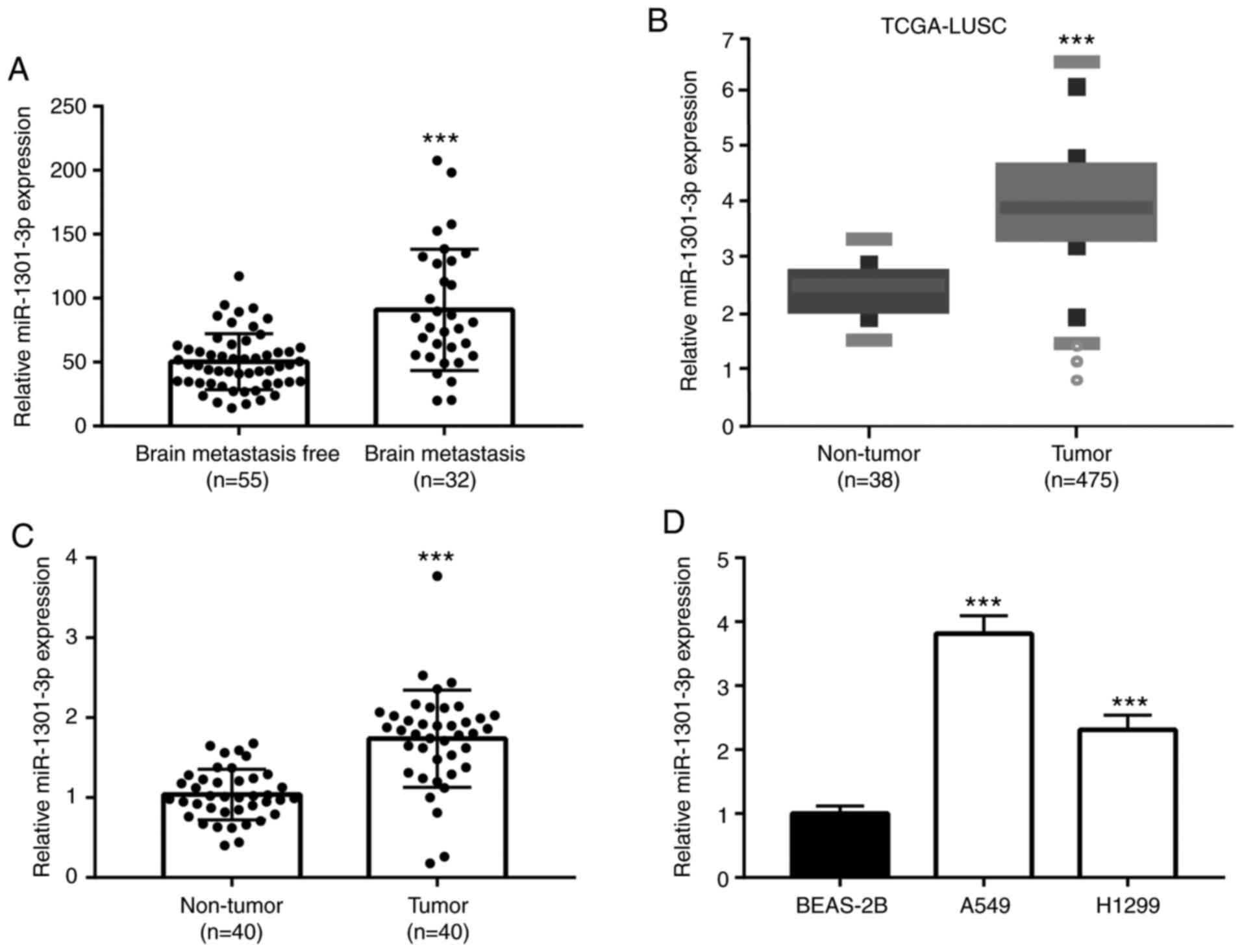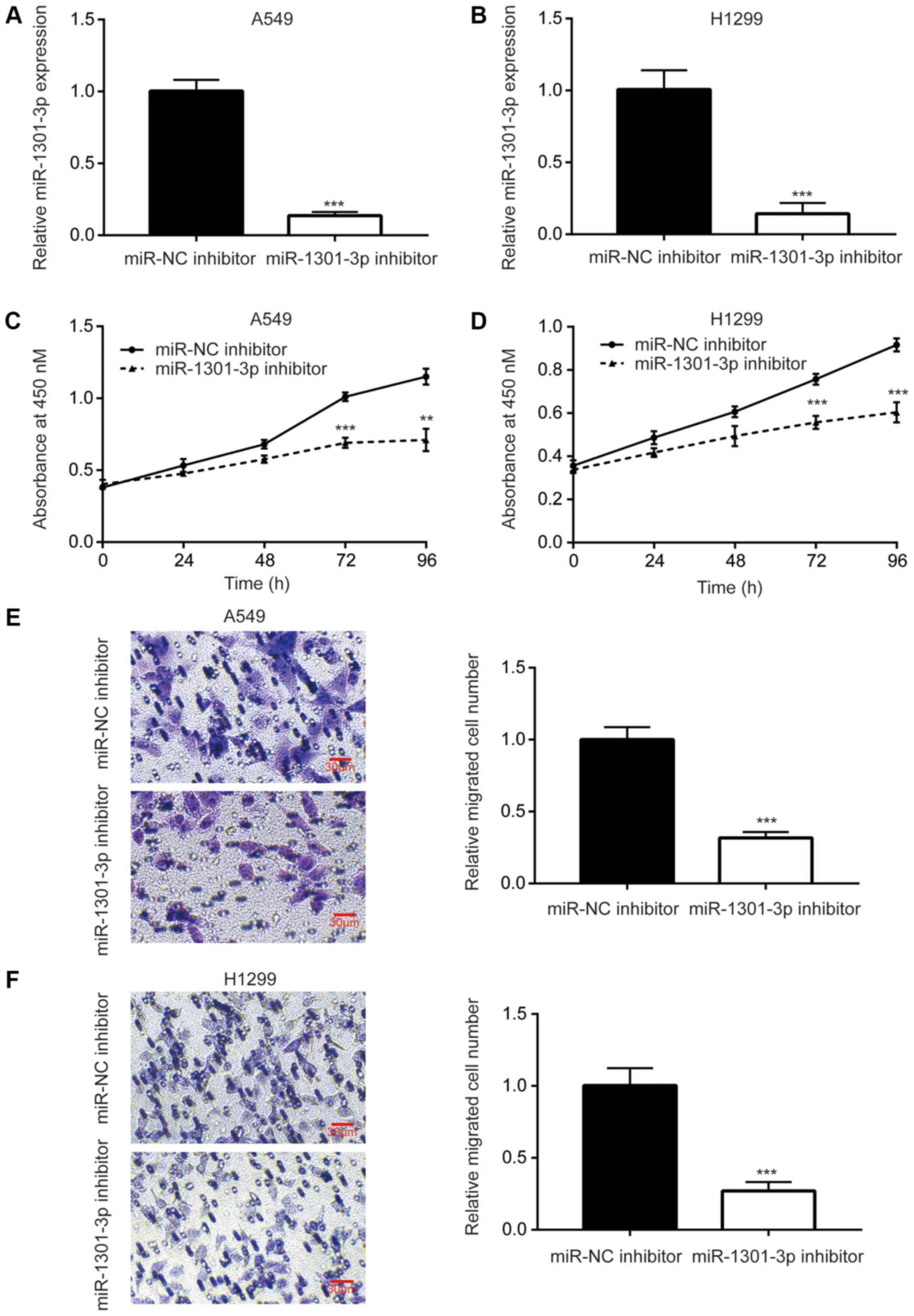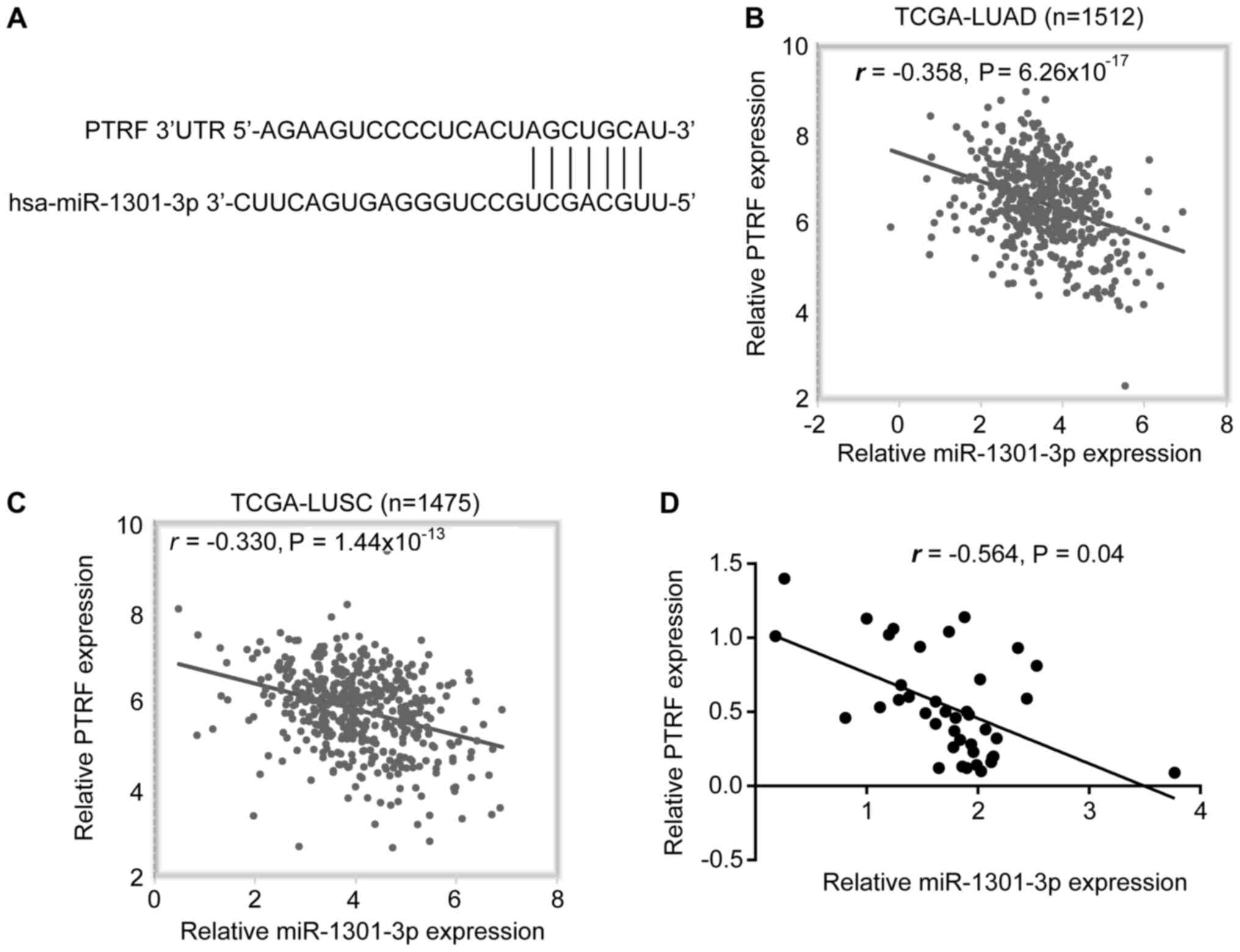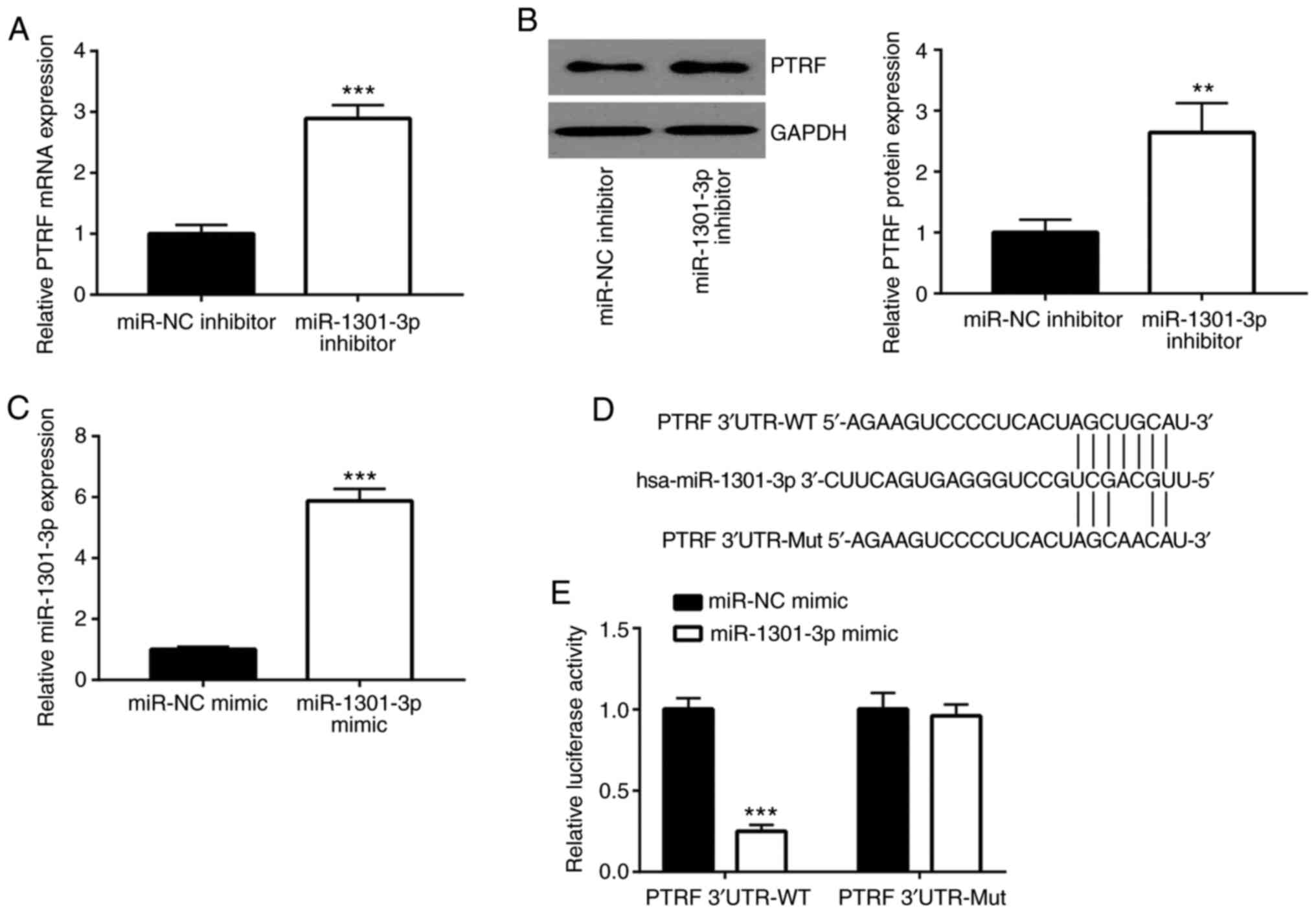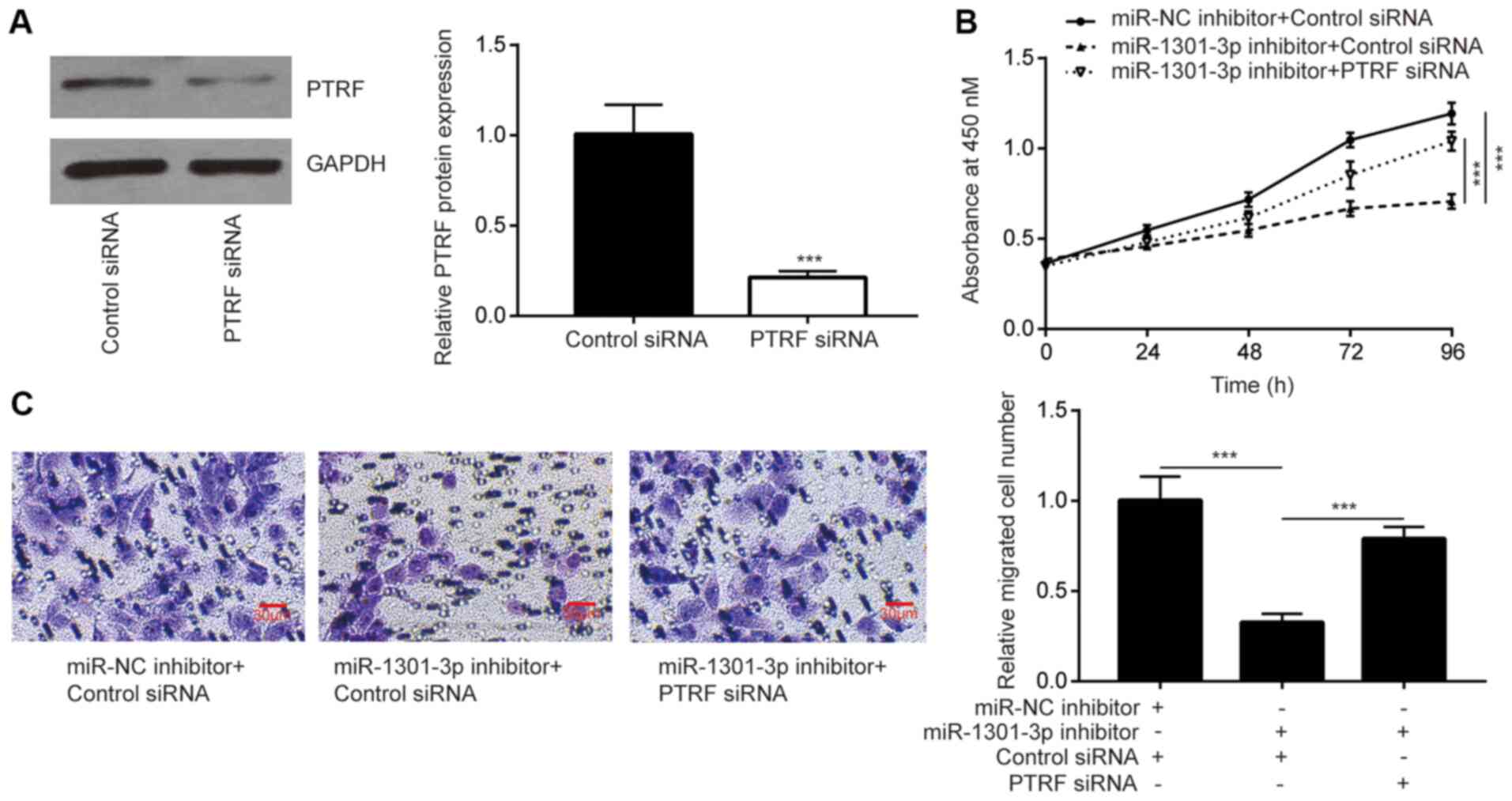Introduction
Globally, lung cancer is the most prevalent cancer
type in both males and females, and there were ~1,760,000 lung
cancer-associated mortalities reported in 2018 (1). The majority of diagnosed lung cancer
cases are histologically classified as non-small cell lung cancer
(NSCLC) (2). NSCLC can be further
divided into several subtypes, of which lung adenocarcinoma (LUAD)
and lung squamous cell carcinoma (LUSC) are the most common types
(3). Although the development of
targeted therapy and cancer screening methods have improved the
prognosis of patients with lung cancer, lung cancer remains a
lethal cancer type for humans, with a 5-year overall survival rate
of <20% (4). The high
proliferative ability and aggressive nature of lung cancer cells is
responsible for the poor prognosis of patients (5).
microRNAs (miRNAs or miRs) are short, non-coding
molecules expressed in mammal cells (6). miRNAs can interact with the
3′-untranslated region (3′UTR) of target mRNAs, causing mRNA to
degrade or for the translation process to stop (7). It is understood that miRNAs control the
expression of key genes in multiple signaling pathways to promote
normal physiological processes, such as cell differentiation and
cell death (8). Dysregulation of
miRNAs disrupts signaling networks and contributes to the
progression of human diseases, including lung cancer (9,10).
Numerous differentially expressed miRNAs have been identified in
lung cancer according to several previous studies via microarray
methods (11–13). Several miRNAs have been confirmed as
key cancer-associated miRNAs in lung cancer via targeting oncogenes
and tumor suppressors (14–16). For example, miR-19b directly
represses protein phosphatase 2 and BIM expression, activates
epidermal growth factor receptor signaling, and promotes cell
proliferation and apoptosis resistance in lung cancer cells
(17). A previous study screened out
numerous differentially expressed miRNAs in lung cancer with brain
metastasis (13). However, the
biological roles and expression patterns of the majority of these
miRNAs have not yet been investigated.
The present study analyzed previously published
microarray data (13) and identified
miR-1301-3p as an upregulated miRNA in lung cancer with brain
metastasis. Therefore, the aim was to investigate the expression,
biological function and molecular mechanisms of miR-1301-3p in lung
cancer cells.
Materials and methods
Patient samples
A total of 40 lung tumor tissue and matched normal
tissue (>3 cm away from cancer) samples were obtained from
patients (29 male and 11 female, age range 35–80 years; median 55
years) with lung cancer at Huadong Hospital Affiliated with Fudan
University (Shanghai, China) between June 2014 and July 2017. All
participants provided written informed consent. Lobectomy was
performed to resect tumors and matched normal tissues from
patients. None of the patients received chemotherapy or
radiotherapy before the surgery and they did not have other
malignancies. The protocol of the experiments was approved by the
Ethical Committee of Huadong Hospital Affiliated with Fudan
University (approval no. FDU201406-2). Specimens were snap-frozen
in liquid nitrogen and stored in a −80°C refrigerator.
Cell culture and cell
transfection
The immortalized lung epithelial cell line BEAS-2B
and lung cancer cell lines A549 and H1299 were purchased from the
American Type Culture Collection. Cells were maintained in DMEM
(Gibco; Thermo Fisher Scientific, Inc.) supplemented with 10% FBS
(Gibco; Thermo Fisher Scientific, Inc.) and 1%
penicillin-streptomycin solution (HyClone; Cytiva) in an incubator
at 37°C with 5% CO2. miR-1301-3p inhibitor
(5′-GAAGUCACUCCCAGGCAGCUGCAA-3′), miR-1301-3p mimic
(5′-UUGCAGCUGCCUGGGAGUGACUUC-3′), miR-negative control (NC) mimic
(5′-UUCUCCGAACGUGUCACGUTT-3′) and miR-NC inhibitor
(5′-CAGUACUUUUGUGUAGUACAA-3′) were obtained from Guangzhou RiboBio
Co., Ltd. A549 and H1299 cells were transfected with 50 nM miRNA
mimic, inhibitor, miR-NC mimic or miR-NC inhibitor using
Lipofectamine 3000 reagent (Invitrogen; Thermo Fisher Scientific,
Inc.) according to the manufacturer's protocol. Polymerase I and
transcript release factor (PTRF) small interfering RNA (siRNA)
(5′-GAGAAGCGCAUGAACAAGCUGTT-3′) and control siRNA
(5′-UUCUCCGAACGUGUCACGUTT-3′) were obtained from Shanghai
GenePharma Co., Ltd. Lipofectamine 3000 was used to transfect 100
nM siRNA into A549 and H1299 cells. After 48 h, the transfection
efficiency was determined by western blotting and reverse
transcription-quantitative PCR (RT-qPCR).
Cell proliferation and migration
assays
The cell proliferation assay was performed with Cell
Counting Kit-8 (CCK-8; Dojindo Molecular Technologies, Inc.). At 0,
24, 48 and 72 h post-transfection, CCK-8 was added to the culture
medium and maintained for 2 h. Subsequently, the absorbance at 450
nM was detected by a i-Mark Microplate Reader (Bio-Rad
Laboratories, Inc.) to measure the cell number.
The migration capacity of cancer cells was detected
with an 8-µm pore size Boyden chamber (EMD Millipore). Cells were
suspended in DMEM containing 0.5% FBS (Gibco; Thermo Fisher
Scientific, Inc.) and seeded in the upper chamber, and DMEM
containing 10% FBS was added to the lower chamber as the
chemoattractant. Following 48 h, cells remaining in the upper side
of the chamber were removed, and cells on the other side of the
chamber were treated with 4% formaldehyde followed by crystal
violet staining at room temperature for 15 min. Three random fields
of miR-NC inhibitor + control siRNA, miR-1301-3p inhibitor +
control siRNA and miR-1301-3p inhibitor + PTRF siRNA groups were
examined with an inverted light microscope (magnification, ×40;
Nikon Corporation) and the number of migrated cells was
analyzed.
RT-qPCR
RNA was collected from cells and tissues using
TRIzol (Invitrogen; Thermo Fisher Scientific, Inc.) according to
the manufacturer's protocol. First-stranded cDNA was synthesized
using M-MLV reverse transcriptase (Invitrogen; Thermo Fisher
Scientific, Inc.) with dNTP set (Invitrogen; Thermo Fisher
Scientific, Inc.) and Random Hexamers (Invitrogen; Thermo Fisher
Scientific, Inc.) according to the manufacturer's protocol. qPCR
was performed with a TB Green Premix Ex Taq™ II kit (Takara Bio,
Inc.) on the CFX96 system (Bio-Rad Laboratories, Inc.). The
thermocycling conditions were as follows: 95°C for 10 sec, followed
by 40 cycles of 95°C for 5 sec and 60°C for 30 sec. mRNA and miRNA
expression were normalized to GAPDH and U6. The 2−ΔΔCq
method (18) was applied to analyze
the relative expression of genes. The primer sequences were as
follows: E-cadherin forward, 5′-AAAGGCCCATTTCCTAAAAACCT-3′ and
reverse, 5′-TGCGTTCTCTATCCAGAGGCT-3′; Vimentin forward,
5′-TGCCGTTGAAGCTGCTAACTA-3′ and reverse,
5′-CCAGAGGGAGTGAATCCAGATTA-3′; PTRF forward,
5′-AGGTCAGCGTCAACGTGAAG-3′ and reverse,
5′-CCGACTCTTTCAGCGATTTGC-3′; GAPDH forward,
5′-CTGGGCTACACTGAGCACC-3′ and reverse 5′-AAGTGGTCGTTGAGGGCAATG-3′;
Stem-loop, 5′-CTCAACTGGTGTCGTGGAGTCGGCAATTCAGTTGAGGAAGTC-3′;
miR-1301-3p forward, 5′-GCCGAGTTGCAGCTGCCTGGGA-3′ and reverse,
5′-CTCAACTGGTGTCGTGGA-3′; and U6 forward,
5′-GCTTCGAGGCAGGTTACATG-3′ and reverse,
5′-GCAACACACAACATCTCCCA-3′.
Western blot analysis
Lysates were obtained from cells using RIPA buffer
(Thermo Fisher Scientific, Inc.) according to the manufacturer's
protocol. The concentration of protein lysates was determined by a
BCA protein assay kit (Thermo Fisher Scientific). PTRF (cat. no.
69036; 1:1,000), E-cadherin (cat. no. 14472; 1:1,000) and vimentin
(cat. no. 5741; 1:1,000) antibodies were purchased from Cell
Signaling Technology, Inc. GAPDH (cat. no. ab8245; 1:5,000) was
obtained from Abcam. Horseradish peroxidase (HRP)-conjugated goat
anti-mouse (cat. no. ab97040; 1:10,000) and HRP-conjugated goat
anti-rabbit (cat. no. ab7090; 1:10,000) were also purchased from
Abcam. Proteins (20 µg) were separated by 8% SDS-PAGE, and then
transferred to a PVDF membrane. The PVDF membrane was blocked with
5% non-fat milk for 1 h at room temperature (25°C), followed by
incubation with the primary antibodies for 1 h at room temperature
and secondary antibodies for 1 h at room temperature. The membrane
was treated with the ECL Western Blotting Substrate (Pierce; Thermo
Fisher Scientific, Inc.) to detect blot signals. The bands were
quantified using ImageJ v1.52 software (National Institutes of
Health).
Bioinformatics analysis
The expression data of miRNAs in lung cancer with
brain metastasis (n=32) and those with non-brain metastasis (n=55)
were obtained from previously published data (13). The association between the expression
of miR-1301-3p and PTRF in LUAD tissues, LUSC tissues and normal
lung tissues was analyzed using the Encyclopedia of RNA
Interactomes (ENCORI) software (http://starbase.sysu.edu.cn/) based on The Cancer
Genome Atlas (TCGA)-LUAD and TCGA-LUSC datasets (http://starbase.sysu.edu.cn/panMirDiffExp.php)
(19). The ENCORI software was also
used to evaluate the expression of miR-1301-3p in TCGA-LUSC
dataset. The prediction of targets of miR-1301-3p and putative
binding sites was performed using TargetScan version 7.2
(http://www.targetscan.org/vert_72/).
Dual-luciferase reporter assay
PTRF 3′UTR was inserted into the pmirGLO vector
(Promega Corporation). pmirGLO-PTRF-Mut (mutant) was established
via introducing two-point mutations into pmirGLO-PTRF-WT
(wild-type). pmirGLO-PTRF-WT or pmirGLO-PTRF-WT were co-transfected
with miR-1301-3p mimic or miR-NC mimic using Lipofectamine 3000
(Thermo Fisher Scientific, Inc.) into A549 cells. After 48 h, the
luciferase activity was detected with a Dual-Luciferase®
Reporter Assay System kit (Promega Corporation). Firefly luciferase
activity was normalized to that of Renilla luciferase.
Statistical analysis
Data were analyzed using GraphPad Prism 5.0
(GraphPad Software, Inc.) and presented as mean ± SD, and P<0.05
was considered to indicate a statistically significant difference.
The experiments were repeated in triplicate. Two groups were
analyzed by unpaired Student's t-test. Multiple groups were
analyzed by one-way analysis of variance with Tukey's post hoc
test. The correlation between miR-1301-3p and PTRF expression
levels was examined with Pearson's correlation test.
Results
miR-1301-3p is increased in lung
cancer
To investigate the miRNAs involved in metastasis of
lung cancer, previously published microarray data (13) were analyzed. It was identified that
miR-1301-3p was one of the miRNAs expressed at a significantly
higher level in lung tumors with brain metastasis (n=32) compared
with those with non-brain metastasis (n=55) (Fig. 1A). Furthermore, the expression of
miR-1301-3p was evaluated in TCGA-LUSC dataset, which included
expression profile data of 38 normal lung tissues and 475 NSCLC
tissues. The results demonstrated that miR-1301-3p was
significantly upregulated in lung cancer tissues compared with
normal lung tissues (Fig. 1B). For
validation, 40 pairs of tumors and matched normal samples were
collected from patients with lung cancer. RT-qPCR revealed that
miR-1301-3p was significantly higher in lung cancer samples
compared with matched normal samples (Fig. 1C). Furthermore, it was observed that
miR-1301-3p expression was significantly higher in A549 and H1299
cells compared with the immortalized lung epithelial cell line
BEAS-2B (Fig. 1D).
Downregulation of miR-1301-3p
suppresses lung cancer cell proliferation and migration
miR-1301-3p inhibitor was transfected into lung
cancer cell lines A549 and H1299. RT-qPCR was then performed to
confirm that miR-1301-3p inhibitor significantly reduced
miR-1301-3p expression in A549 and H1299 cells (Fig. 2A and B). miR-1301-3p inhibitor
significantly suppressed the proliferation of A549 and H1299 cells
at 72 and 96 h (Fig. 2C and D). In
addition, Transwell assay demonstrated that miR-1301-3p inhibitor
significantly decreased the number of A549 and H1299 cells that
migrated through the membrane (Fig. 2E
and F). These data demonstrated that miR-1301-3p is associated
with lung cancer cell proliferation and migration.
PTRF is suppressed by miR-1301-3p
Using TargetScan, several genes were predicted as
targets of miR-1301-3p. It was identified that there was a
complementary site for miR-1301-3p on the 3′UTR of PTRF (Fig. 3A). Using ENCORI software, it was
further demonstrated that the miR-1301-3p expression level was
significantly negatively correlated with the PTRF mRNA expression
level in 1,512 LUAD samples and 1,475 LUSC samples from TCGA-LUAD
and TCGA-LUSC, respectively (Fig. 3B and
C). Additionally, it was identified that there was a negative
correlation between miR-1301-3p and PTFR mRNA level in the
collected patient samples (n=40; Fig.
3D).
Due to the higher expression of miR-1301-3p in A549
cells compared with that of H1299 cells, A549 were selected as a
model to explore the molecular mechanism of miR-1301-3p in lung
cancer. In A549 cells, miR-1301-3p inhibitor significantly
increased PTRF mRNA expression level (Fig. 4A). Western blotting further
demonstrated that miR-1301-3p inhibitor significantly increased
PTRF protein level in A549 cells (Fig.
4B). Subsequently miR-1301-3p mimic was transfected into A549
cells to increase miR-1301-3p expression (Fig. 4C). Luciferase plasmids containing the
3′UTR of PTRF (PTRF 3′UTR-WT) or PTRF 3′UTR-Mut (with two-point
mutations in the putative binding site) were constructed (Fig. 4D). Dual-luciferase reporter assay
demonstrated that miR-1301-3p mimic significantly downregulated the
luciferase activity of PTRF 3′UTR-WT, but not of PTRF 3′UTR-Mut in
A549 cells (Fig. 4E).
miR-1301-3p regulates the expression
of epithelial-mesenchymal transition (EMT) markers
PTRF is involved in the EMT process in lung cancer
(20). In the present study, RT-qPCR
demonstrated that miR-1301-3p inhibitor significantly increased
E-cadherin and significantly decreased vimentin mRNA expression
levels in A549 cells (Fig. 5A).
Furthermore, western blotting revealed that miR-1301-3p inhibitor
significantly increased E-cadherin and significantly decreased
vimentin protein expression levels in A549 cells (Fig. 5B). These data indicated that
miR-1301-3p regulates the EMT process in lung cancer.
Knockdown of PTRF attenuates the
effect of miR-1301-3p downregulation in lung cancer
To evaluate the involvement of PTRF in
miR-1301-3p-mediated cell proliferation and migration, PTRF siRNA
was transfected into A549 cells. Western blotting confirmed that
PTRF siRNA significantly decreased PTRF protein expression in A549
cells (Fig. 6A). By performing a
CCK-8 assay, it was identified that PTRF-knockdown significantly
reversed the effect of miR-1301-3p inhibitor on cell proliferation
in A549 cells (Fig. 6B).
Furthermore, in the migration assay, PTRF-knockdown significantly
reversed the effect of miR-1301-3p on the migration of A549 cells
(Fig. 6C). These data implied that
miR-1301-3p facilitates cell proliferation and migration via
targeting PTRF.
Discussion
A number of studies have suggested that miRNAs are
involved in lung cancer progression (4,5);
however, the functions of numerous miRNAs have not yet been
studied. The role of miR-1301-3p in human cancer is controversial.
miR-1301-3p expression is lower in serum samples of patients with
colorectal cancer compared with those from healthy volunteers
(21). miR-1301-3p is downregulated
in pancreatic adenocarcinoma (22).
However, upregulation of miR-1301-3p has been observed in prostate
cancer (23). The present study
re-analyzed the previously published microarray data and discovered
that miR-1301-3p is increased in lung cancer with brain metastasis
compared with those with non-brain metastasis. It was further
confirmed that miR-1301-3p was increased in lung tumors compared
with matched normal tissues. miR-1301-3p promotes or inhibits cell
growth in different cell backgrounds. In prostate cancer,
miR-1301-3p targets ubiquitination factor E4B, activates the p53
signaling pathway and suppresses cancer cell metastasis (24). It has also been reported that
miR-1301-3p targets PPP2R2C and promotes anchorage-dependent and
independent cell proliferation in prostate cancer cells (23). Using CCK-8 and migration assays, the
present study demonstrated that miR-1301-3p enhanced cell
proliferation and migration of lung cancer. These data indicated
that upregulation of miR-1301-3p may mediate lung cancer cell
proliferation and migration. The current study evaluated the role
of miR-1301-3p in lung cancer cells via in vitro assays.
However, in vivo assays may provide several novel findings
for investigating the function of miR-1301-3p in lung cancer. In
the future, a mouse model will be used to study the involvement of
miR-1301-3p in the initiation and development of lung cancer.
PTRF, also known as CAVIN1, is essential for the
formation of caveolae (25). PTRF is
a tumor suppressor in multiple cancer types (20,26–29). For
example, PTRF overexpression restores caveolae formation, reduces
matrix metalloproteinase-9 expression and inhibits the migration of
metastatic prostate cancer cells (29). In lung cancer, PTRF inhibits the EMT
process and suppresses the cell proliferation and metastasis
(20). The downregulation of PTRF is
associated with dysregulation of miRNAs and DNA methylation in
cancer cells (20,30). Via bioinformatics analysis, the
present study identified that PTRF is a potential target of
miR-1301-3p. The expression of miR-1301-3p was shown to be
negatively correlated with PTRF in TCGA-LUAD and TCGA-LUSC
datasets. In addition, a dual-luciferase reporter assay confirmed
that miR-1301-3p targeted PTRF in A549 cells, indicating
miR-1301-3p is a novel regulator of PTRF. The EMT process is
essential for the metastatic potential of lung cancer cells and is
associated with dysregulation of miRNAs (31–33).
PTRF inhibits the EMT process in cancer cells (20). Consistently, it was identified that
miR-1301-3p regulated the expression of key genes involved in the
EMT process. Furthermore, silencing of PTRF attenuated the effect
of miR-1301-3p downregulation on A549 cells. The results indicated
that the miR-1301-3p/PTRF axis controls the EMT process and lung
cancer cell metastasis. However, although the present study
demonstrated a negative correlation between miR-1301-3p levels and
PTRF mRNA levels, and it was experimentally revealed that
miR-1301-3p targeted and repressed PTRF expression in lung cancer
cells, several other mechanisms, such as post-translational
modification may also regulate PTRF at the protein level. Future
studies are needed to investigate the complex signaling network
that regulates PTRF expression in lung cancer.
In conclusion, the current study revealed
miR-1301-3p as a novel upregulated miRNA in lung cancer.
miR-1301-3p was demonstrated to target PTRF and facilitate lung
cancer cell proliferation and migration. Therefore, miR-1301-3p may
be a promising biomarker for patients with lung cancer.
Acknowledgements
Not applicable.
Funding
The current study was funded by the National Youth
Science Foundation (grant no. 81702252), the Healthy and Planning
Commission Youth Program of Shanghai (grant no. 20164Y0160) and the
Healthy and Planning Commission Program of Shanghai (grant no.
201840188).
Availability of materials and data
The datasets used and/or analyzed during the current
study are available from the corresponding author on reasonable
request. The results published here are in whole or part based upon
data generated by the TCGA Research Network: https://www.cancer.gov/tcga.
Authors' contributions
YunW, QS, XC, YueW, YN and FL performed the
experiments and analyzed the data. YunW and QS collected clinical
samples. QS and FL were major contributors in conception, design
and writing the manuscript. All authors read and approved the final
manuscript.
Ethics approval and consent to
participate
All participants provided written informed consent.
The protocol of the experiments was approved by the Ethical
Committee of Huadong Hospital Affiliated with Fudan University
(Shanghai, China) (approval no. FDU201406-2).
Patient consent for participation
Not applicable.
Competing interests
The authors declare that they have no competing
interests.
References
|
1
|
Bray F, Ferlay J, Soerjomataram I, Siegel
RL, Torre LA and Jemal A: Global cancer statistics 2018: GLOBOCAN
estimates of incidence and mortality worldwide for 36 cancers in
185 countries. CA Cancer J Clin. 68:394–424. 2018.PubMed/NCBI
|
|
2
|
Herbst RS, Morgensztern D and Boshoff C:
The biology and management of non-small cell lung cancer. Nature.
553:446–454. 2018.PubMed/NCBI
|
|
3
|
Chen Z, Fillmore CM, Hammerman PS, Kim CF
and Wong KK: Non-small-cell lung cancers: A heterogeneous set of
diseases. Nat Rev Cancer. 14:535–546. 2014.PubMed/NCBI
|
|
4
|
Hirono T, Jingushi K, Nagata T, Sato M,
Minami K, Aoki M, Takeda AH, Umehara T, Egawa H, Nakatsuji Y, et
al: MicroRNA-130b functions as an oncomiRNA in non-small cell lung
cancer by targeting tissue inhibitor of metalloproteinase-2. Sci
Rep. 9:69562019.PubMed/NCBI
|
|
5
|
Wang R, Chen XF and Shu YQ: Prediction of
non-small cell lung cancer metastasis-associated microRNAs using
bioinformatics. Am J Cancer Res. 5:32–51. 2014.PubMed/NCBI
|
|
6
|
Yates LA, Norbury CJ and Gilbert RJ: The
long and short of microRNA. Cell. 153:516–519. 2013.PubMed/NCBI
|
|
7
|
Zhao Y and Srivastava D: A developmental
view of microRNA function. Trends Biochem Sci. 32:189–197.
2007.PubMed/NCBI
|
|
8
|
Bartel DP: MicroRNAs: Genomics,
biogenesis, mechanism, and function. Cell. 116:281–297.
2004.PubMed/NCBI
|
|
9
|
Wang Y, Liang Y and Lu Q: MicroRNA
epigenetic alterations: Predicting biomarkers and therapeutic
targets in human diseases. Clin Genet. 74:307–315. 2008.PubMed/NCBI
|
|
10
|
Zhang B, Pan X, Cobb GP and Anderson TA:
MicroRNAs as oncogenes and tumor suppressors. Dev Biol. 302:1–12.
2007.PubMed/NCBI
|
|
11
|
Zhang Y, Sui J, Shen X, Li C, Yao W, Hong
W, Peng H, Pu Y, Yin L and Liang G: Differential expression
profiles of microRNAs as potential biomarkers for the early
diagnosis of lung cancer. Oncol Rep. 37:3543–3553. 2017.PubMed/NCBI
|
|
12
|
Tamiya H, Mitani A, Saito A, Ishimori T,
Saito M, Isago H, Jo T, Yamauchi Y, Tanaka G and Nagase T: Exosomal
microRNA expression profiling in patients with lung
adenocarcinoma-associated malignant pleural effusion. Anticancer
Res. 38:6707–6714. 2018.PubMed/NCBI
|
|
13
|
Sun G, Ding X, Bi N, Wang Z, Wu L, Zhou W,
Zhao Z, Wang J, Zhang W, Fan J, et al: Molecular predictors of
brain metastasis-related microRNAs in lung adenocarcinoma. PLoS
Genet. 15:e10078882019.PubMed/NCBI
|
|
14
|
Mavridis K, Gueugnon F, Petit-Courty A,
Courty Y, Barascu A, Guyetant S and Scorilas A: The oncomiR miR-197
is a novel prognostic indicator for non-small cell lung cancer
patients. Br J Cancer. 112:1527–1535. 2015.PubMed/NCBI
|
|
15
|
Zhu J, Wang S, Chen Y, Li X, Jiang Y, Yang
X, Li Y, Wang X, Meng Y, Zhu M, et al: Mir-19 targeting of GSK3β
mediates sulforaphane suppression of lung cancer stem cells. J Nutr
Biochem. 44:80–91. 2017.PubMed/NCBI
|
|
16
|
Grosso S, Doyen J, Parks SK, Bertero T,
Paye A, Cardinaud B, Gounon P, Lacas-Gervais S, Noël A, Pouysségur
J, et al: MiR-210 promotes a hypoxic phenotype and increases
radioresistance in human lung cancer cell lines. Cell Death Dis.
4:e5442013.PubMed/NCBI
|
|
17
|
Baumgartner U, Berger F, Hashemi Gheinani
A, Burgener SS, Monastyrskaya K and Vassella E: miR-19b enhances
proliferation and apoptosis resistance via the EGFR signaling
pathway by targeting PP2A and BIM in non-small cell lung cancer.
Mol Cancer. 17:442018.PubMed/NCBI
|
|
18
|
Livak KJ and Schmittgen TD: Analysis of
relative gene expression data using real-time quantitative PCR and
the 2(-Delta Delta C(T)) method. Methods. 25:402–408.
2001.PubMed/NCBI
|
|
19
|
Zhou KR, Liu S, Cai L and Bin L: ENCORI:
The encyclopedia of RNA interactomes.
|
|
20
|
Cai Y, Ruan J, Yao X, Zhao L and Wang B:
MicroRNA-187 modulates epithelial-mesenchymal transition by
targeting PTRF in non-small cell lung cancer. Oncol Rep.
37:2787–2794. 2017.PubMed/NCBI
|
|
21
|
Wang L, Zhao Y, Xu M, Zhou F and Yan J:
Serum miR-1301-3p, miR-335-5p, miR-28-5p, and their target B7-H3
may serve as novel biomarkers for colorectal cancer. J BUON.
24:1120–1127. 2019.PubMed/NCBI
|
|
22
|
Dou D, Yang S, Lin Y and Zhang J: An
eight-miRNA signature expression-based risk scoring system for
prediction of survival in pancreatic adenocarcinoma. Cancer
Biomark. 23:79–93. 2018.PubMed/NCBI
|
|
23
|
Bi D, Ning H, Liu S, Que X and Ding K:
miR-1301 promotes prostate cancer proliferation through directly
targeting PPP2R2C. Biomed Pharmacother. 81:25–30. 2016.PubMed/NCBI
|
|
24
|
Wang B, Wu H, Chai C, Lewis J, Pichiorri
F, Eisenstat DD, Pomeroy SL and Leng RP: MicroRNA-1301 suppresses
tumor cell migration and invasion by targeting the p53/UBE4B
pathway in multiple human cancer cells. Cancer Lett. 401:20–32.
2017.PubMed/NCBI
|
|
25
|
Liu L and Pilch PF: A critical role of
cavin (polymerase I and transcript release factor) in caveolae
formation and organization. J Biol Chem. 283:4314–4322.
2008.PubMed/NCBI
|
|
26
|
Gamez-Pozo A, Sanchez-Navarro I, Calvo E,
Agulló-Ortuño MT, López-Vacas R, Díaz E, Camafeita E, Nistal M,
Madero R, Espinosa E, et al: PTRF/cavin-1 and MIF proteins are
identified as non-small cell lung cancer biomarkers by label-free
proteomics. PLoS One. 7:e337522012.PubMed/NCBI
|
|
27
|
Nassar ZD, Moon H, Duong T, Neo L, Hill
MM, Francois M, Parton RG and Parat MO: PTRF/Cavin-1 decreases
prostate cancer angiogenesis and lymphangiogenesis. Oncotarget.
4:1844–1855. 2013.PubMed/NCBI
|
|
28
|
Yi JS, Mun DG, Lee H, Park JS, Lee JW, Lee
JS, Kim SJ, Cho BR, Lee SW and Ko YG: PTRF/cavin-1 is essential for
multidrug resistance in cancer cells. J Proteome Res. 12:605–614.
2013.PubMed/NCBI
|
|
29
|
Aung CS, Hill MM, Bastiani M, Parton RG
and Parat MO: PTRF-cavin-1 expression decreases the migration of
PC3 prostate cancer cells: Role of matrix metalloprotease 9. Eur J
Cell Biol. 90:136–142. 2011.PubMed/NCBI
|
|
30
|
Peng J, Liu HZ, Zhong J, Deng ZF, Tie CR,
Rao Q, Xu W, You T, Li J, Cai CB, et al: MicroRNA187 is an
independent prognostic factor in lung cancer and promotes lung
cancer cell invasion via targeting of PTRF. Oncol Rep.
36:2609–2618. 2016.PubMed/NCBI
|
|
31
|
Yochum ZA, Cades J, Wang H, Chatterjee S,
Simons BW, O'Brien JP, Khetarpal SK, Lemtiri-Chlieh G, Myers KV,
Huang EH, et al: Targeting the EMT transcription factor TWIST1
overcomes resistance to EGFR inhibitors in EGFR-mutant
non-small-cell lung cancer. Oncogene. 38:656–670. 2019.PubMed/NCBI
|
|
32
|
Dai L, Chen F, Zheng Y, Zhang D, Qian B,
Ji H, Long F and Cretoiu D: miR-21 regulates growth and EMT in lung
cancer cells via PTEN/Akt/GSK3β signaling. Front Biosci (Landmark
Ed). 24:1426–1439. 2019.PubMed/NCBI
|
|
33
|
Amaar YG and Reeves ME: RASSF1C regulates
miR-33a and EMT marker gene expression in lung cancer cells.
Oncotarget. 10:123–132. 2019.PubMed/NCBI
|















